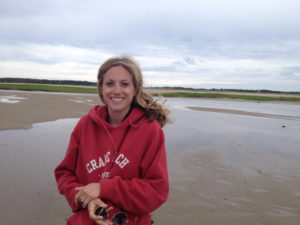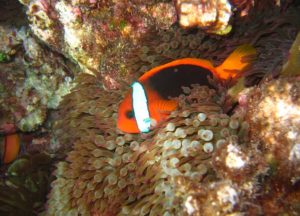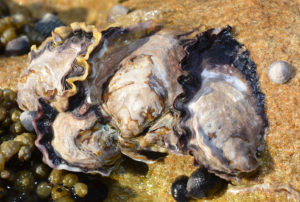by Kristen Minogue

Sarah Donelan in Wellfleet, Massachusetts.
(Credit: Patricia Donelan)
Every parent wants to give their children the best shot at life. But sometimes, this means more than protecting newborns after birth. Some species can prepare offspring for tough conditions before they enter the world. It’s called transgenerational plasticity. Sarah Donelan, a Smithsonian Environmental Research Center postdoc, has spent years piecing together how it works. This November she published a new article highlighting how humans could be changing this age-old parental strategy. Discover more in the Q&A here.
This interview has been edited and condensed for clarity.
How does “transgenerational plasticity” allow parents to change their offspring’s development?
Basically, the environment that an adult experiences during its own lifetime can have effects on how its offspring behaves and how its child goes throughout its own life. It’s easy to understand in humans, because transgenerational plasticity affects humans. There’s terrible things like fetal alcohol syndrome, where the actual environment of the baby in the womb affects the personality of the offspring.
But then in our conceptual paper, we also look at how parents can give information to their offspring without talking to them. They do this via passing along chemicals, like hormones, that can help or hurt the offspring during their lives, or by making sure their offspring are born in a certain environment, a better environment versus a worse environment. And that can have lifelong effects.

Red and black anemonefish in the Great Barrier Reef. Research has revealed that if parents of coral reef fish experience ocean acidification, their offspring are better adapted to deal with it. (Credit: Richard Ling)
What are some animals that experience this?
There’s some cool work in coral reef fish. There’s work out of Australia that has shown that increased acidification and temperature have negative effects on coral reef fish metabolism. So they’re more stressed. Their heart rate is higher, and they grow less. But there’s work that shows that when parents are in acidified and warm conditions, the offspring aren’t affected negatively. That negative effect goes away.
Are there certain situations where this strategy works really well?
In certain situations, we hypothesize in this paper, the environmental stressors are just exacerbations—stressors that organisms have seen previously. But now they’re getting more extreme. And so we predict that in those situations, parental effects, transgenerational plasticity, may be beneficial.
When could it backfire?
Increasingly, environments are becoming more novel than in the past, by the introductions of entirely novel cues like road noise or buildings going up. Parents can’t accurately perceive what those cues are, or they may misinterpret what those environmental cues are, and so either not give any information to their offspring, which could be detrimental, or give the wrong information to their offspring…
For instance, the combined cues of increased day length and warming historically were associated with the onset of spring. If those things become decoupled, such that warming happens earlier and doesn’t couple with day length, a parent that is adapted to understand those two cues as being related isn’t going to interpret the new conditions correctly. And that might affect when they reproduce, where they reproduce, and that could have effects on offspring.
How are we as humans changing the rules?
Environmental change is happening quickly, more quickly than in the past. And then it’s also just the increased variability makes it such that in past situations, where parent environments were likely to be correlated with offspring environments, those correlations are disappearing. Depending on the lifespan of the organisms, it’s going to be less likely for a parent’s environment to predict the offspring’s environment.
How do parents deploy the “bet hedging” strategy?
“Bet hedging” occurs when the environment is so variable that the parents have no idea what the future environment of their offspring is going to be. And so they make offspring a variety of different phenotypes to hedge their bets that one or some of them are going to be well-suited for that environment—while some of them will be ill-suited for the environment and therefore might die. And so we predict that bet hedging might become this strategy that’s increasingly common, because it’s going to be increasingly unlikely for parental environments to predict offspring environments.
What does your latest paper add to the discussion?
We see our paper as a call for transgenerational [plasticity] just to be better incorporated into the literature, We had trouble finding empirical examples of a lot of our hypotheses, because people haven’t explored it empirically. We hope that the paper gives our colleagues ideas about specific hypotheses to test, in terms of how the introduction of novel cues will affect transgenerational plasticity.

Sydney Rock Oysters (Credit: John Turnbull)
How could it help conservation, knowing how transgenerational plasticity works?
We need to better understand the conditions that favor it. We can’t really think about incorporating it into restoration or conservation without having a better understanding of how it’s actually going to be helping the specific organisms that we are interested in….
There’s another example out of Australia with oysters, Sydney rock oysters, where it’s again with ocean acidification and again showing that parental experience with acidified conditions helps larval oysters survive in those conditions. These concepts could be integrated into restoration. If an oyster farm or if an oyster restoration site is occurring in a suboptimal environment where conditions are acidified, we can manipulate parental experiences with these stressors before the offspring are born, and so the offspring might survive better.
What does this mean for some of the animals people see outside in their yards?
Organisms are products of all the environments that they’ve been in. So if you see a butterfly in your garden, monarchs are migratory and so the environment that a monarch experienced in Mexico or further south is still affecting how it’s behaving in your garden. It’s still affecting the flowers it’s choosing or how it’s interacting with other butterflies, how it’s avoiding predators.
Even in nature organisms are products of their past. And I think that that’s a really good thing to remember, in that we have to think all ecosystems are connected. Especially for organisms that are transient, thinking about maintaining a good global environment.
Photo of red and black anemone fish used by permission of Creative Commons License 2.0 BY-NC-ND. Photo of Sydney rock oysters used by permission of Creative Commons License 2.0 BY-NC-SA.
More Weird Science Stories
Cannibalism, Sex Change and Other Strange Ways Animals Deal with Social Pressure
The Secret Formula to Feeding 900 Babies
More Scientist Q&As:
Katrina Lohan: Marine Parasite Hunter
Kim Komatsu: Ecosystem Conservation Ecologist
Erica Staaterman: What Does Life In The Ocean Sound Like?
Emmett Duffy: The Heart Of The Ocean

